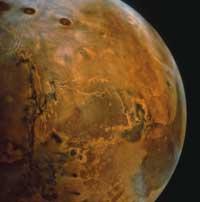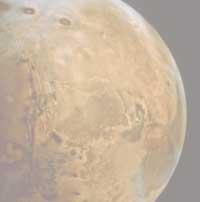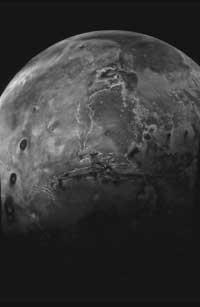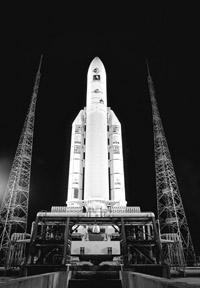Martitz, we return
1996/11/01 Irazabalbeitia, Inaki - kimikaria eta zientzia-dibulgatzaileaElhuyar Fundazioa Iturria: Elhuyar aldizkaria

These romantic stories and beliefs ended when humans began exploring space through probes and satellites. Mariner 9 made it clear in 1971 that there was no water in the channels of the red planet and that the exotic princesses to rescue were inventors of sovereign writers. However, many scientists remained in the hope that life would live on Mars, but twenty years ago, specifically on July 20, 1976, when Viking1 left on the Zir plain, it was stated that life, the slightest trace, was a dream.
This data has led us to believe in the humility of Mars for years. But, of course from the corner, in a meteorite of Martian origin traces of primitive bacteria have been found in Antarctica. This news stirred up scientists in August and reignited the debate about Martitz's life. Surely there is no martyr green, but some simple bacteria would be enough for people who claim the universality of life to have strong handles.
A month and a half later, on September 3, 1976, the Viking 2 twin probe was stationed at Martitz. It ended human efforts to get to know Martitz better, as the subsequent missions, the twin Phobos probes of the 1979 Soviets, have failed urgently.
However, it seems that there is no disease that lasts a thousand years and that this year the exploration of Martitz will again get to the top. Three missions, three, that will revolve around the space to visit our red light district: Martitz 96 of the Russians and the American Masters Explorer (Mars Pathfinder) and the Mars Global Surveyor Earth Meter.
Tuesday 96
This mission is great news in the Russian space program. After the failure of the missions of Fobos (eight years ago), this will be the first mission to launch the depth of space.

The latest news indicates that next November 16 will depart from the space center Martitz 96 Baiconur. At least Alexander Moisheiev, head of the mission, said this.
That day the rockets of pitcher Proton will take the land out of Baiconur. Leaving behind the trail of fire, it will space more than 5,000 kilos of the probe. Ten months later, specifically on September 12, 1997, he will reach Mars. However, it will not start working immediately, as the probe the planet is orbiting will take a few weeks to work per week. However, the mission is already underway.
The Martitz 96 space consists of an orbiter, two small landing modules and two drills. Five days before reaching Martitz's orbit, the probes will eject the lander modules and they will land on Martitz's surface. The drills will remain longer tied to the main ship and will be entered into the orbit of the planet and will depart at two weeks to drill the surface of Mars. Both the lander and drill will work for 3 months. The entire mission will last a minimum of one year.
Mariz Explorer

On December 3 a Delta II launcher will launch the Mars Explorer. Eight months later, in July 1997, the 819 kilogram probe came to its name. The ship will consist of two main elements: the lander and the microparrot. The first will stop at the demarcation point and transmit the data from the area to the Earth, while that of the microchambers, on the contrary, will be able to wander and cover a larger plot with the data issued.
Global Earth Meter on Mars
This American mission will be the first to travel to Mars, as its release date will be November 6. Date to be determined. The Delta II launcher will space the orbiter over 1,000 kilos. In September 1997 it will reach Mars, but it will not be incorporated immediately. Martitz's surface mapping will begin in April or May of the following year. During these seven months the ship's speed will be reduced by aerobization and will reach its definitive orbit entering the high atmosphere of Mars. This process must be done slowly and cautiously.
Those of us who think that the exploration of space, and especially that of the planets of the Solar System, is an important task, we apparently have a reason for joy. And the implementation of these three missions can indicate that we are at the gates of a more prosperous era. Good luck!
Mission
Martitz 96 Explorer of Mariz Global Corridor
Gai honi buruzko eduki gehiago
Elhuyarrek garatutako teknologia





